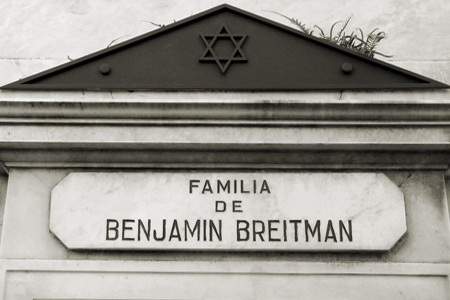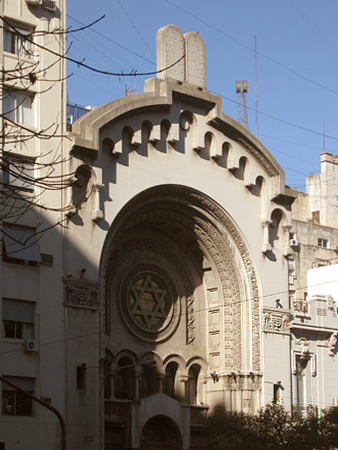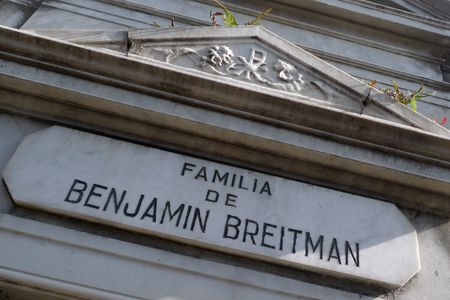A single Jewish tomb reminds visitors of the multi-denominational character of Buenos Aires. Although it sits unoccupied today, this iswas the only tomb in Recoleta Cemetery decorated with a Star of David:

When the cemetery was founded in 1822, the majority of the city’s population was Catholic so it was blessed accordingly. During the presidency of Bartolomé Mitre the blessing was officially removed when he insisted that a prominent member of the Masonic Order be buried there. Or so the story goes. These days, all public cemeteries in Buenos Aires are non-denominational. However given the conservative class of the families present, Recoleta Cemetery remains 99% Catholic.
Not much is known about Benjamín Breitman or how he came to purchase a plot, but the history of Jewish burials in Argentina began with the establishment of the community in Argentina. Founded in the 1860s the Templo Libertad on Plaza Lavalle may not be the oldest synagogue in Buenos Aires, but it was the most important for early Jewish immigrants:

Jewish tradition foregoes ostentatious burials, given that all are equal after death. The largest non-Catholic cemetery during the early years of the Jewish community in Buenos Aires was the Cementerio de Victoria (now Plaza 1º de Mayo). Sponsored mainly by the Protestant community & 50% funded by the UK, Jews & Protestants were buried together at the same location. Popularly referred to as the Cementerio de los Disidentes, it filled to capacity during the 1871 yellow fever epidemic. Back then if you weren’t Catholic, then you must be a dissident.
The Jewish community had an opportunity to claim part of Chacarita Cemetery when it opened but opted to wait for their own burial ground. In 1912 the Cementerio de Liniers opened (actually just outside the city limits of Buenos Aires) exclusively for Jews & was mainly for those of Ashkenazi descent. Being buried there still remains a sign of high status within the community. Jews of Moroccan descent—many referred to as “impure” based on their connections with the mafia—opened a cemetery south of Buenos Aires in Avellaneda. It is currently closed. In 1936, another cemetery was opened for poorer Jews in Tablada & the newest cemetery in Ciudadela is typically for those of Sephardic descent. All these cemeteries are closed to visitors.
Jewish funeral rites are unique but unfortunately beyond the scope of this blog. Many thanks to Leonor Slavsky for sharing her investigations at talks sponsored by the Instituto Histórico.
—————————————————
Update (30 Jul 2010): Earlier this year the plaque with the Star of David on the Benjamín Breitman family tomb was removed. Reasons are unknown for the removal, but Marcelo unexpectedly found another vault with possible Jewish symbolism.

Update (18 mar 2011): According to a comment below, the plaque fell from the tomb from neglect & is now stored in the Administration office for safekeeping.
Update (31 May 2013): According to the Find A Grave website, Benjamín Breitman passed away on 04 Mar 2012 & was buried in his family tomb the following day. Thanks to Raúl for the info!
Interesting tidbit from “From Pale to Pampa: A Social History of the Jews of Buenos Aires” by Eugene Sofer (p. 48): in 1921 the city of BsAs authorized the construction of a Jewish cemetery within the city limits. However, the Sociedad de Beneficencia bought the adjacent land and then pressured the city council into reversing its decision to allow the Jewish cemetery. A fight ensued between the Socialists (opposing the Jewish cemetery) and the Radicals (supporting it). Eventually permission was revoked, the land was sold, and land for a Jewish cemetery in the Province was purchased. The city council then passed a resolution barring creation of any more cemeteries within city limits.
Very interesting… guess that was the birth of what was named the Cementerio de Liniers at the time. Ah, the wonderful Sociedad de Beneficencia. Maybe Eva Perón had the right idea about doing away with them 🙂
The plaque from the family tomb of Benjamin Breitman was not removed, it fell off and is currently in the office of the cemetery director. Dr. Francavilla, the director, told me the tomb seems to be abandoned and nobody claims the plaque, but the cemetery direction will restore it in due course.
Thank you very much for this bit of information. I should change the text to say “removed from neglect.” I wonder if Breitman will claim the plaque someday…
Mr. Benjamin Gregorio Breitman died on March 4, 2012 and was buried at his vault at the Recoleta’s cemetery on March 5, 2012 at 11.30 AM.
For read more: http://www.findagrave.com/cgi-bin/fg.cgi?page=gr&GRid=86286686
Best regards!
Thank you for the information, Raúl! I was not aware that Mr. Breitman had passed away… I will change the post to reflect this. Saludos!
Soy el hijo de Benjamin Breitman: habieno leido estos comentarios, le respondo al Dr
Francavilla, que por lo que deduzco es el director del Cementerio de la Recoleta, que la
Boveda de la Familia Breitman no se encuentra abandonada. Que existe una casilla al
lado de la misma que es ilegal, ( esto fue admitido por el señor Luis Fanchelli del sector
de obras de la direccion nacional de cementerios) Dicha casilla provoca humedades en
nuestra boveda. Me han prometido muchisimas vezes que la iban a retirar, pero no han
cumplido la promesa. Estamos dependiendo de la retirada de la casilla para poder hacer
los arreglos correspondientes en nuestra boveda.Roberto Gabriel Breitman
Hola Sr Breitman – Muchísimas gracias por tomar el tiempo de leer el post y dejar un comentario. El Dr Francavilla se jubiló el año pasado, y en su lugar quedó Susana Gesualdi como directora del cementerio. Muchas veces vi la casilla al lado y ahora entiendo mejor la situación de su familia. Espero que se arregle pronto! Gracias por su aporte. Saludos cordiales, Robert
La “casilla ilegal” es una de las decenas de lugares asignados a los cuidadores del cementerio para guardar los elementos que usan para su trabajo diario, e inclusive sus ropas de trabajo, ya que no hay espacio físico para guardar esas cosas. Si da una caminata por el cementerio verá que en todo los sectores encontrará esas,-como dice usted-, “casillas” que están cerradas con cadena y candado y mayormente sus puertas de madera están pintadas de color gris. No son “ilegales”, están aceptadas por la dirección del lugar desde siempre y que se conozca, jamás ha habido problemas. La familia Breitman no paga los servicios de cuidadores, es más, varios días antes del fallecimiento del Sr. Gregorio Breitman, su hijo concurrió con una persona ajena al cementerio para limpiar rápidamente el lugar que estaba completamente abandonado, lleno de yuyos y suciedad, además del triángulo con la Estrella de David que había caído durante una fuerte tormenta y estaba guardado hacía más de 2 años en la dirección del cementerio. Luego del sepelio del señor Breitman en marzo de 2012, el lugar jamás se volvió a limpiar y se puede ver claramente como los yuyos volvieron a crecer en su interior y las telarañas se adueñaron de los vidrios de las puertas.
Que tal? Ando mucho por el cementerio y hoy encontré esta tumba de casualidad y me acordé de este post. La placa con la estrella de david ya está puesta en la fachada y la tumba está definitivamente ocupada. Le saque una foto, por si te interesa!
Hola María Victoria – Pues sí! Por fin volvió… gracias por la colaboración. Un saludo!
Hello,
I want you to be well.
I am Ndue Hoti from the neighborhood “Beslidhja”, the city of Lezhe, located in the village of GORRE’-Kurbin, Albania, I want to know the burial place of my maternal uncle Franco/Francisco/French T. ALKAJ (1905-?). Franco Alkaj emigrated due to persecution by the Albanian communist regime to Italy, he landed in the port of Buenos Aires on July 11, 1948 where he gained the status of a (political) immigrant by changing only his name, from Albanian Frano to Spanish Franco(1948)/Francisco(1966) ) and according to some of the few data in GOOGLE, Franco was in B. Aires until 1966, verified by a bulletin, where Francisco Alkaj (42 years old), the president of the Argentine Republic, gave him a pension, like all immigrants and according to a former colleague of his prof. Isuf Luzaj(1913-2000), Franco died in B. Aires, but Luzaj was in a serious state of health and alone in the hospital room, and I did not understand the address well, so I could not find other information about the person close to my mother. , who as far as we know left no heirs.
Franco/Francisco, did not let us know about his situation in emigration because he was protected from Albanian discovery for himself and for my mother’s family.
Please help us to know the location of the burial place of the person close to my mother Gjyste Bajraktari Hoti (1938-2020).
With Respect
NDUE HOTI
Cel:++355 67 68 27 093
e-mail:hotindue@yahoo.com
Hello Ndue – Thank you for your comment & sharing your family history! There is probably not enough information for either Marcelo or I to discover the burial location of your uncle, but we will try. I will email you if we find something. Best of luck!